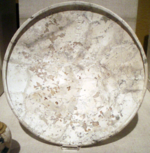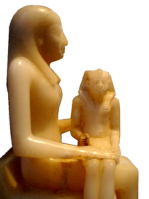OK
Here is the list of the Egyptian Dynasties and their Pharaohs (the dates vary from source to source, I am using the list as can be found in N. Grimmal’s A History of Ancient Egypt. The dates and the short descriptions from M. Rice Who’s Who in Ancient Egypt):
2700 – 2190 B.C. – The Old Kingdom
2686 – 2667 B.C. Nebka (=Sankht?) was the first king of the third dynasty, who may have been the son of Nemaathap, the daughter of Khaskhemwy. Sankht was responsible for innovations in connection with the kingship (the first to enclose his name in the famous cartouche). His burial-place is unknown, but is probably located in Saqqara.
2667 – 2648 B.C. Djoser-Netjerykhet was probably the brother of Sankht, Djoser is the first king to be revered not only as a king, but also as a god. Though he is known today as Djoser, this name was given to him well after his death, his Horus name during his lifetime was Netjerykhet. Djoser’s reign is immortalised by the Step Pyramid complex at Saqqara, the first monumental stone building in the history of the world, which was designed and constructed by his vizier Imhotep. Both technology and the arts flourished, as well as the increasing complex civil service. Throughout the next two and a half thousand years, Djoser was worshiped by the Egyptian people, while Imhotep became the only non-royal persona to become a god.

Sekhmkhet's pyramid copmlex at Saqqara
2648 – 2640 B.C. Sekhemkhet. It is unknown what relation Shekhemet was to Djoser, perhaps he was Djoser;s son-in-law. Not much is known of his reign, however, he is one of history’s mysteries. His pyramid is located in Saqarra, and when Egyptologists uncovered his sarcophagus they discovered that not only was it empty, but it never contained a body…
2640 – 2637 B.C. Khaba was another obscure king whose existence was once doubted.
2637 – 2613 B.C. Huni was the last king of the third dynasty. His reign is obscure and his burial-place is unknown. One of his lesser wives, Meresankh, might have been the ancestress of the fourth dynasty. He might have been the instigator behind the building of the Medium Pyramid, though it was Senefru his successor who eventually had it finished.
2589 – 2566 B.C. Khufu was the son of Snefru and Hetepheres I. Little is known of his reign which lasted for more than twenty years. Only one known portrait of his survived, this ivory statuette of Khufu enthroned found at Abydos. Khufu is forever immortalised because of the Great Pyramid in Giza which he built during his reign. It was, and still is, one of the seven great wonders of the world. Khufu was worshipped for at least a thousand years after his death.
2566 – 2558 B.C. Djedefre. After Khufu’s death there was a matter of dispute regarding his heir. Eventually, Djedefre succeeded his father and performed his death rites as his son and heir, He also married Hetepheres II, the wife of Kawab who was the legitimate heir to the throne but who died before his father. Djedefre began to build his pyramid in Abu Rawash, however, it seems that his court plotted against him and replaced him with Khafre, another son of Khufu. The pyramid was never completed, though if it would have it would have been quite a sight.
2558 – 2532 B.C. Khafre was the son of Khufu and who reigned for more than twenty years. Khafre’s name is associated with the second pyramid of Giza, which is smaller than the Great Pyramid. Traditionally, it was also thought that Khafre was the face of the Great Sphinx.
Baefre (?) It is unknown when this king reigned exactly, it is possible that he was another son of Khufu and that he reigned for a very short while, either just before Khafre or just before. He is mentioned in Meneto’s list of kings and his name is mentioned in a twelfth dynasty inscription and he had a cult that worshipped him throughout the Old Kingdom.
2532 – 2503 B.C. Menkare was the son of Khafre and was the instigator of the third, and smallest, pyramid at Giza.
2503 – 2498 B.C. Shepseskaf was most likely the son of Menkaure, and was married to his sister, Khentkawes. Unlike his predecessors, Shepesekaf built a mastaba, instead of a pyramid, in Saqqara.
2494 – 2487 B.C. Userkaf was likely to have been the son of Djedefre’s daughter, he married the Queen Khentkawes, daughter of Mankaure. in order to reinforce his claim to the throne. Userkaf had a pyramid built-in Saqqara and was the first to build a sun temple that became the trade mark of the kings of the fifth dynasty.
2487 – 2475 B.C. Sahure was the son of Khentkawes, thus he succeeded the throne. He gave particular prominence to the cults of the sun-god and he moved the royal necropolis to Abushir where he built a relatively modest pyramid with a sun-temple attached. His reign was notable for the trading activity and for various expeditions against marauding tribes which had been harassing the Egyptian borders for some time.
2475 – 2455 B.C. Neferirskare – Kakai was the brother of Sahure and the son of Khentkawes. Though his reign is unknown, stories telling of his deeds have survived showing him to have been a kindly king.
2455 – 2448 B.C. Shepseskare Isi is an obscure king, unknown what his relationship to the previous king. All is known is that his reign may have lasted for seven years.
2448 – 2445 B.C. Neferefre, though he died young and did not reign for long, his reign was rich and prosperous, as attested by the large number of papyrus documents containing royal decrees that were found in his unfinished pyramid.
2455 – 2421 B.C. Neuseme was the son of Neferirkare and Khentkawes, he reigned for twenty-five years and was a devotee of the solar cult associated with the kings of the fifth dynasty. He was also the first king to divide Egypt into nomes, administrative units which continued to be in use throughout Egyptian history. He was honoured for a very ling period after his death and he built a pyramid in Abusir next to his father, mother and brother.
2421 – 2414 B.C. Menkauhor. Though little is known of this king, his relationship to the previous king, and of his short reign, he was worshipped by the Egyptians for a long time after his death, even into the New Kingdom.
2414 – 2375 B.C. Djedkare-Isesi‘s reign might have been as long as forty years, and was probably the most peaceful reign during the latter part of the Old Kingdom. He also encouraged long-distance expeditions, including perhaps to Punt (?). He was buried in a pyramid to the south of Saqqara.
2375 – 2345 B.C. Wenis was the last king of the fifth dynasty reigned peacefully for thirty years, He is chiefly remembered as the first king to have the Pyramid Texts inscribed on the interior wall of his pyramid at Saqqara. The causeway to his sarcophagus contained dramatic scenes of famine in Egypt.
2345 – 2323 B.C. Teti was the first king of the sixth dynasty, who most likely came to the throne by marrying the daughter of the previous king. Teti reigned for at leat twelve years and his principal queen was Iput. It would appear that Teti was assassinated and that he was buried in his pyramid in Saqqara, which was covered with the Pyramid Texts.
2321 B.C. Userkare might have been a descendant of the kings of the fifth dynasty and is thought to have ruled for only a year, perhaps during the minority of Pepi I.
2321 – 2287 B.C. Pepi I was most likely the son of Teti and was a child when the latter was assassinated. There was general unrest during Pepi’s reign, it is known that he had led expeditions to deal with an uprising of the tribes in Canaan and into the south of Nubia. There may have been a plot at one time hatched by one of queens to assassinate him. The copper statue of Pepi was an early and fine example of work in copper on such a large-scale. He reigned for more than forty years.
2287 – 2278 B.C. Merenre I was the son of Pepi I and Ankhenesmerye, and was probably co-regent with Pepi towards the end of the latter’s reign. He might have died when he was still just a young man.
2278 – 2184 B.C. Pepi II was the brother of Merenre I and was six years old when he succeeded to the throne. His reign is known as one of the most prosperous and it was in his time that he gave estates to officials to reward their loyalty. This will later become the reason for the weakening of the central government. It is said that Pepi was the longest-reigning monarch in Egypt, reigning for more than ninety years, making him a hundred years old when he died.
2184 B.C. Merenre II was the son of Pepi II and only reigned for one year. According to legend, Merenre II was assassinated by a mob and his queen, Nitiqret, avenged his death before taking her own life.
2184 – 2181 B.C. Nitocris was the wife of Merenre II and who was the last monarch of the sixth dynasty. It is unknown whether she truly existed, but if she did, she was the first woman to assume the full powers of kingship. She is also mentioned by Herodotus.




















